This is Naked Capitalism fundraising week. 1131 donors have already invested in our efforts to combat corruption and predatory conduct, particularly in the financial realm. Please join us and participate via our donation page, which shows how to give via check, credit card, debit card, or PayPal. Read about why we’re doing this fundraiser, what we’ve accomplished in the last year, and our fifth target, more original reporting.
One of the facts of life of the online publishing is that the overwhelming majority of sites, measured in terms of traffic and influence, run advertising. As much as it’s routinely acknowledged that journalism has been in a crisis for nearly 20 years as budgets and headcounts have been slashed, that crisis is at its root an advertising crisis. Half of newspaper ad revenues once came from classified ads. When that shrank radically due to competition from Craigslist and other free online listing services, the content side was put on a Procrustean bed. Lifestyle sections remained largely untouched, since they are by design ad venues, and their articles are mainly publicist placements and hence cost little to gin up. It was the news side that took the brunt of the cuts.
Now some sites are able to make a go of it on donor contributions alone. Others, almost entirely sites with investment-related content, have a subscription-ony model and they throw the occasional piece over the paywall for promotional purposes. And some sites are run by solo bloggers as a by-product of their day job, which means the proprietor treats it as a secondary activity, say as as a venue for the writer to increase his network or get feedback on his ideas, or as a marketing vehicle.
As we’ve mentioned from time to time, we run a hybrid revenue model. We as you know full well, run an annual fundraiser because neither advertising alone, with the considerable restrictions we put on the type of ads we allow on NC, nor an once-a-year fundraiser, produce enough to cover the nut for this operation.
We don’t have a philosophical objection to advertising because no single advertiser provides a meaningful amount of our revenue, hence we are not hostage to anyone. And advertisers aren’t even placing ads on NC per se. Our ads are sold by a third party service and Naked Capitalism is part of a “vertical” as in we are pitched as a group buy along with similar sites (in terms of demographics) for premium ad campaigns. The rest of our ads are “remnant” ads, which our ad service claims to optimize at a higher rate than its competitors. The one downside of that is that readers might get the occasional ad they deem to be offensive, like one for a Presidential candidate they loathe, or for a TBTF bank’s products. I initially react badly when I see them too, but I’ve learned to become Zen about them: to the extent the wrong people wind up advertising here, they are unwittingly supporting the opposition.
The big objection we have to a lot of ads (and I say “we” because I include Lambert in many of these decisions) is aesthetic. Ads look kinda cheesy. The print version of the New York Times, and even its online version, manages to preserve that Serious Player look even with ads, but many Serious Sites are think tanks (like the Council for Foreign Relations) which means they are funded by big backers and can spend lots of money perfecting their look and feel (McKinsey has long spent a lot of time and money on its visual presentation, and they are not alone). They have a spare, clean visual vocabulary that emulates that of policy documents.
Naked Capitalism, by contrast, has always had a “letter from the gulag” look, and ads sit awkwardly in that. But as we’ll discuss very soon, we actually reject a lot of high-payout per view (per CPM, in the lingo) because we deem them to be too intrusive or downright tacky. So while it may not be evident to you, we are already taking a bit hit in revenue terms in the interest of keeping readers focused on our content. Since we often make complex arguments with a lot of information, we don’t want you to be distracted.
And it’s not as if ads can’t be pretty or interesting or entertaining, even though few seem to reach that level. When I was a kid and we got our first TV (yes I am so old as to have been born when most families did not have TV), I am told I watched commercials but not the programs. Below is a sample of some well-loved commercials:
So I’ve wondered if typically unappealing state of Internet advertising really is native to the platform, or whether it reflects unconscious resentment among ad agencies and advertisers. Having worked briefly with marketers, it seems that the most fun (and often most lucrative) activity for them is commercials. The internet has sucked a lot of eyeballs away from TV. And even though I can’t imagine it’s impossible to be creative and do fun and interesting work in a very different medium, if they are used to vastly larger budgets and more time, the response to the new design parameters appears for many to be to do throwaway work.
Now we do have times when our ad service fails to ask if we are willing to accept ads of the type we’ve said we aren’t keen about, and they slip through. Generally we catch or are told about it sooner rather than later. But to give you an idea of how stringent we’ve been, below are examples of the type of ads that we’ve rejected (thank Lambert for rounding them up).
First are the ubiquitous clickbait ads. I can’t tell you how many times our ad service has told us we are giving up Big Bucks by not having one of these so-called “Adblades” sit beneath each article, meaning between the article and the comments section. I’m not willing to have something so large that it impedes readers who read an article from seeing that we do have a comments section (and thus being encouraged to proceed and participate), and that’s before you get to the uber tacky factor:
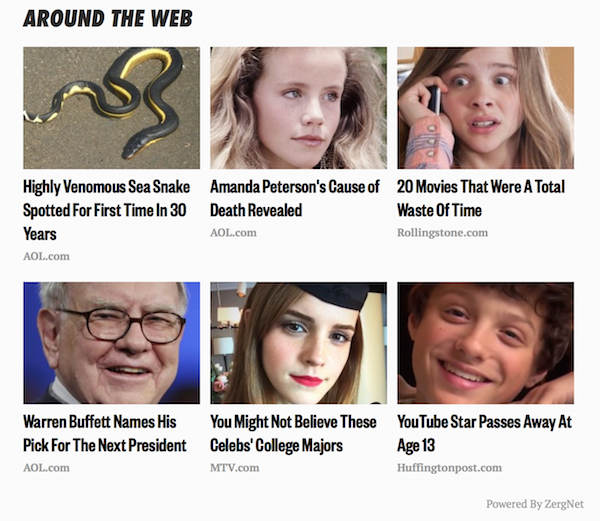
This is called a “Native Ad Sidebar”. You can see even though it would sit in what we call the “right rail” as in our right column, and thus not be very intrusive, it would not look very “native” to NC. But readers are meant to think that we somehow chose and therefore endorse the featured content.
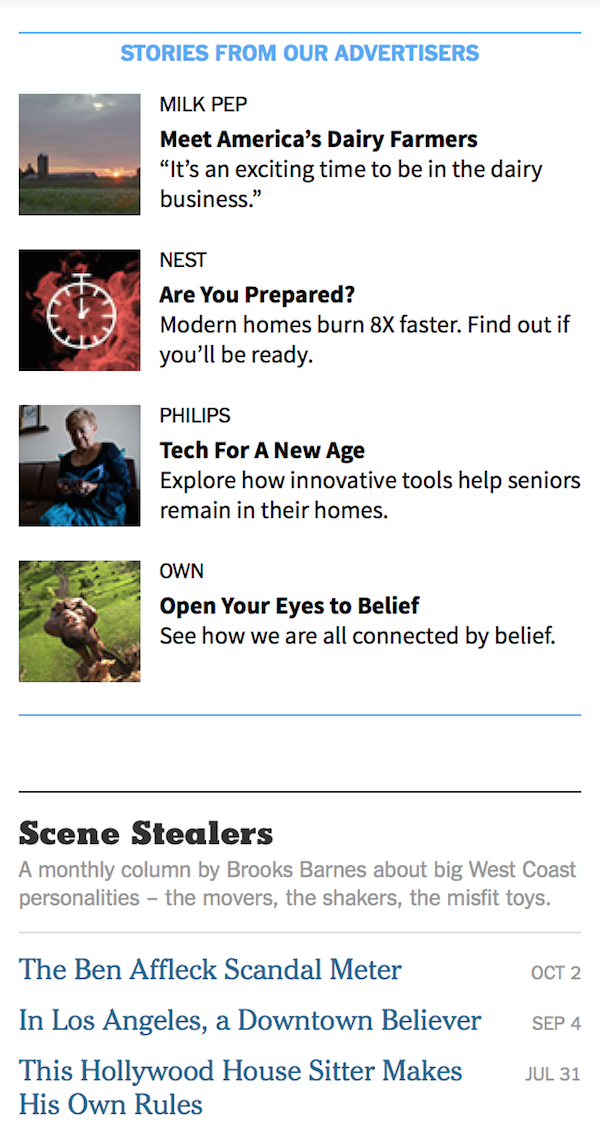
We did for a while have Newsmax, which was about as good as it gets in this category. It sat in the “right rail,” it had a simple, clean layout, and its links were to almost entirely economic and political articles. Even then, we told Newsmax that it had to screen out its most right-wing content, which amounted to 20% of its publishers, by name. So even when we have run advertising in this category, we’ve invested more in managerial time than other sites would to run it.
But most other “native ads” are far more intrusive, as in they sit right below or even worse, in the actual text of articles. They are meant not just to get readers to encounter the click-through headline or content, as the case may be. The advertiser also gets an image buff by being associated so seamlessly with the publisher, particularly if the publisher has a strong brand image. Consider this one from the International Business Times:
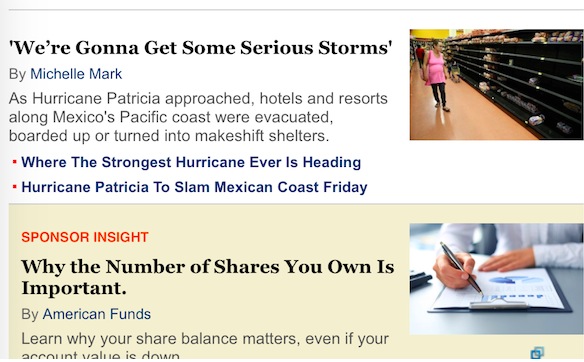
A reader has to be moderately alert to recognize that the article in the beige box is from an advertiser, not an IBT writer. Even though it does say “Sponsored Content” and is demarcated by the change in background color, it otherwise has the same layout as an International Business Times story and sits right below one. In other words, it is designed to be deceptive. And this particular one gives investment advice, something we strenuously avoid doing.
The Wall Street Journal is even more subtle about this sort of thing, which is arguably worse:

And I have no idea what some of these advertisers are thinking. Just because you’ve inserted a pop-up does not mean anyone will be interested in it, particularly when the ad is so clearly far removed from the topic of the story. And that makes it even more annoying:
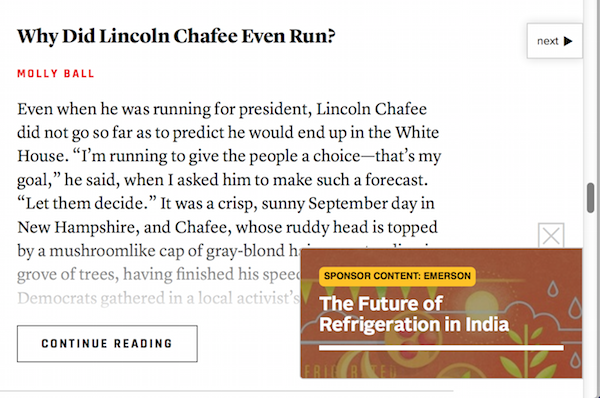
Lambert took it upon himself to mark up these ads, again of the sort we’ve rejected, since the static versions don’t give you the same feel as when you encounter them in the wild. Here’s another “what were they thinking” sort, in terms of the association of the ad with the copy, along with the distraction of having an ad in the middle of text:
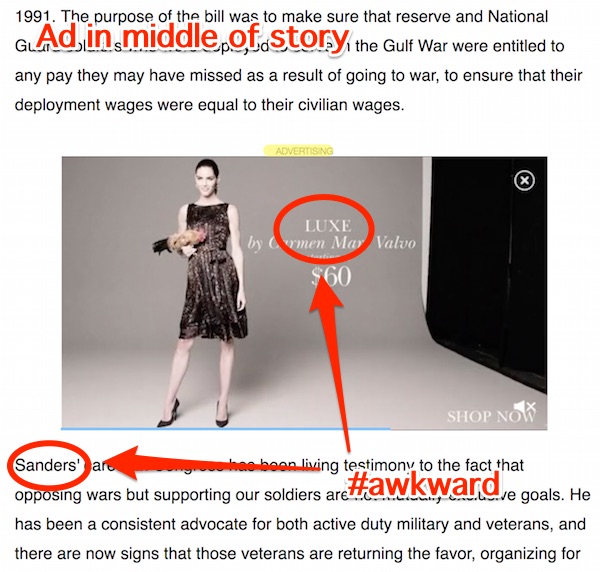
This one is a video in the midst of a text article. The first is how it looks when you stumble across it:
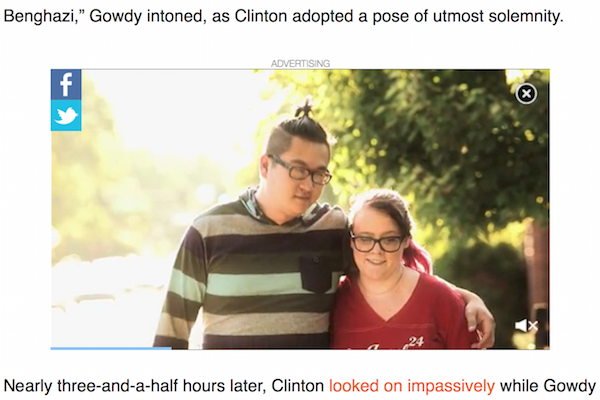
Lambert marked it up to try to give a sense of what happens:
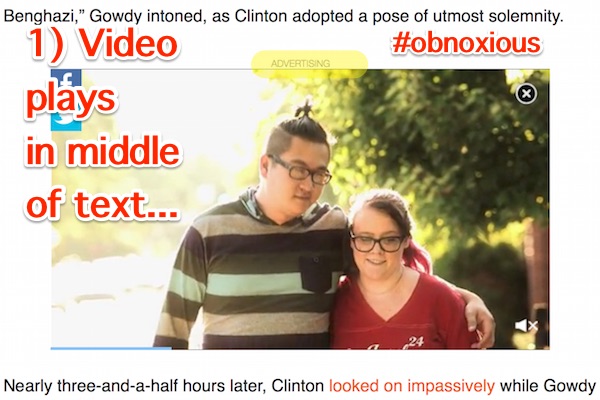
Here you’ve got TWO ads plunked over a single story:

And worse, one of them is a hard to close video ad!

And this one might not seem problematic until you consider the Faceborg factor:
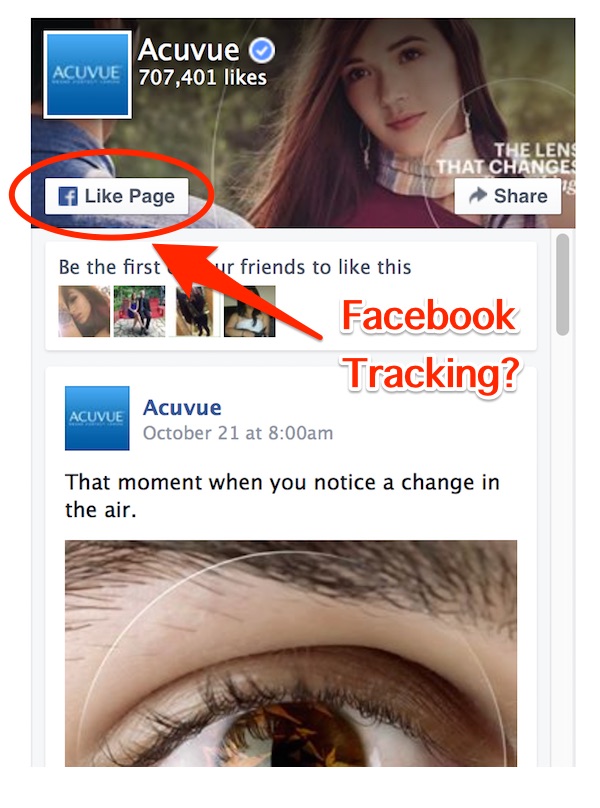
So from our perspective, keeping Naked Capitalism reader-friendly, and in particular, preserving our comments section, means we have to be vigilant about the ads we accept. So we are making serious revenue sacrifices on behalf of improving the experience of the community. We thus appreciate as well as depend on your support in this fundraiser. If you haven’t yet had a chance to donate, we hope you’ll take a minute now to visit our fundraiser page, which shows you how to give by check, debit or credit card, or PayPal. If you can give a little, that helps us meet our goals, and if you can give a lot, we hope you’ll give a lot. And if you can’t make a financial gift, you can help us by sharing what you are learning here with family, friends, and colleagues. Thanks again for participating in this community!


OMG I just scrolled through it and need to run out side and roll in the grass, hug a tree, attacked by insects, just to feel human again… I can feel the needle from the cortex injection attempting to pierce my brain stem… aaaggggh – !!!!!!!
Report of the APA Task Force on Advertising and Children
Introduction
Download summary & report (PDF, 617KB)
Advertising is hardly a recent human endeavor; archaeologists have uncovered signs advertising property for rent dating back to ancient Rome and Pompeii. Town criers were another early form of advertising. As an industry, advertising did not take off until the arrival of the various mass media: printing, radio, and television. Nevertheless, concerns over advertising targeting children preceded both radio and television. The British Parliament passed legislation in 1874 intended to protect children from the efforts of merchants to induce them to buy products and assume debt.
Commercial appeals to children, however, did not become commonplace until the advent and widespread adoption of television and grew exponentially with the advent of cable television, which allowed programmers to develop entire channels of child-oriented programming and advertising. Opportunities to advertise to children further expanded with the explosive growth of the Internet, and thousands of child-oriented Web sites with advertising content have appeared in the past few years.
Compounding the growth in channels for advertising targeting children has been another development: the privatization of children’s media use. A recent study found that a majority of all U.S. children have televisions in their bedrooms. Many children also have unsupervised access to computers, meaning that much of the media (and advertising) content that children view is in contexts absent parental monitoring and supervision.
These two trends—the growth in advertising channels reaching children and the privatization of children’s media use—have resulted in a dramatic increase in advertising directly intended for the eyes and ears of children. It is estimated that advertisers spend more than $12 billion per year to reach the youth market and that children view more than 40,000 commercials each year. These figures represent dramatic increases over those from the 1970s.
The Task Force on Advertising and Children, responding to its charge, began by reviewing research on the impact of advertising on children, 2 with particular attention given both to the implications of children’s cognitive development for understanding the potential effects of exposure to advertising and to specific harms that might result from exposure to advertising. There is a substantial body of scientific evidence addressing all of these basic issues. In contrast, concerns about advertising that have emerged as a result of new and changing technological capabilities, such as interactive forms of advertising and commercial Web sites targeting children, have yet to attract almost any empirical study. Consequently, our research review and conclusions are largely confined to more traditional advertising approaches, although we identify the issues in need of further research
http://www.apa.org/pubs/info/reports/advertising-children.aspx
Earlier this month a Connecticut middle school banned students from blurting out the catchphrase for a Geico commercial in the hallways. Not surprisingly these transgressions would spike on Wednesdays also known as “Hump Day.” Eleven year olds incessantly remind each other “What day is it?” to a cacophony of “Hump Daaaaaay!…Yeah!” and a chorus of “Woot!” “Woot!”
Geico spends nearly a billion dollars a year in marketing, a strategy that has produced profound sales growth. Recently the company passed Allstate to become the nation’s second largest seller of car insurance. The brand has a history of delighting audiences with entertaining stories with characters that include cavemen, a gecko, and Maxwell the pig. But why has this one, a seemingly absurd concept of a camel annoying his colleagues, risen to the top to become the most shared ad of this summer and perhaps all year?
The answer lies in the base of our brain and the origins of our evolution. The human brain is the only organ in the body that exists in evolutionary layers. We often falsely convince ourselves that the most recent Neocortex, or “thinking brain,” is running the show because it is the part of our mind that talks to ourselves. However it is the deeper “feeling brains”: our “limbic/emotional system” and the “physical (instinctual) brain” at the bottom that often commandeer our bodies into action without our own awareness.
In his highly influential, revolutionary book The Selfish Gene, British evolutionary biologist Richard Dawkins coined the term “meme”—a unit of cultural information that is transmitted from mind to mind through imitation and replication in a manner analogous to the spread of genes. Memes replicate like viruses and include tunes, slogans, catchphrases, fashions, styles, and rituals.
Our brain is quite literally a “survival organ” and most of the memes in our culture reflect the deepest, instinctual drives of our reptilian legacy, or what I have coined the Six S’s— survival, safety, security, sustenance, sex, and status. These themes are so often at the roots of many of the most prolific memes because they are both completely unconscious in origin and utterly important to our own survival. Messages reflecting these six S’s, unwittingly force our attention, which is also why we crane our neck to check out the horrible accident along the highway despite our own protests.
So the real reason “hump day” is a viral hit is simple. While the execution and casting of Caleb the camel is perfect, what’s really driving the viral nature is that the ad is constructed around a metaphor for having sex. Implicit metaphors intimating our deepest strivings bypass critical thinking and strike at the heart and gut, the part that moves people unknowingly to action. I don’t believe the ad was designed with this mind. Great creators intuitively develop a feeling for what works often without their own conscious awareness. And there are a ton of examples of this in action.
https://www.psychologytoday.com/blog/unconscious-branding/201310/how-advertising-infects-your-children-s-minds-and-yours
And some wonder why monkeys masturbate so much in captivity… their confronted with homo economicus every day for a Jawb…
Skippy… everything is OK – https://www.youtube.com/watch?v=gF9MUnkIlQc
Of course advertising appeals to our instinctive predispositions–the “monkey brain” if you will–because this is what moves the widgets. On a recent edition of Ralph Nader’s podcast his sister, a California anthropology professor, was talking about her studies of how the rest of the world views “the West” and particularly the US. She said they view us as technologically brilliant but utterly materialistic and unspiritual. As such they might be appalled to see us brainwashing our children to buy things. However from an American perspective we are simply teaching them to be good patriotic consumers. As George W. Bush said after 9/11: go out and buy.
None of which is to criticize NC ads of course, as they advance the cause. But imo we should always view advertising as the commercial propaganda that it is. If you want to locate the ground zero of America’s dysfunction it could very well not be on Wall Street but uptown on Madison Avenue.
Some times I ask myself whom were the humans… the colonists or the indigenous sapiens…
. . . read “One Vast Winter Count” and you’ll get your answer.
That looks like a great book for hunkering down with this winter. Thanks!
Seconded
The 2004 APA link to which you refer is ancient history since the onset of “flipped classrooms” with “personalized”-one-laptop-per-child education and 2008, 2011 deregulation of FERPA (Family Educational Rights and Privacy Act).
Which illustrates Gates CORE advancement with iholes providing the interface, even then they can’t help themselves and loot from day one…. amazing incentives…
Skippy… even the wife’s work [paramedic] has swapped out hardened lappies for them.
My current favorite “tell” is someone making the swiping motion when they are confronted with something they don’t like.
“it’s not working!!”
I’m such an old throwback that I can remember the very early days of the Internet back in, oh, it must have been around 1993/4-ish. Advertising wasn’t worth the bother because of the small potential audience size.
Well. I’ve stuck with it for 20+ years, but now I’ve pretty much thrown in the towel. The sole reason is the assault on the senses (video adds take it beyond just visual clutter, you’ve got the auditory distraction plus the need for manual dexterity to shut the bloody things off via their intentionally hard-to-find off buttons) that so many sites have now become. I limit myself to a handful of carefully picked go-to’s (the Guardian, the BBC, the Financial Times, Wikipedia plus a few specialist sites. And Naked Capitalism naturellement.)
I’ve even gone back to paper statements from banks and utilities. My poor enfeebled brain simply cannot tolerate what the World Wide Web has degenerated into.
Another example of the despoiling of the Commons.
Are you using Web Of Trust, or one of its’ competitors? We find that the volume of advertising we encounter in our internet usage is cut to manageable levels with this service. WOT is free, for some arcane reason. I’ll take that risible “Manage AddOns” banner at the bottom of my screen that pops up from time to time in exchange for a little peace and quiet. You have to enable it for each Web browser you use, but that’s a small price to pay. I figure Yves might be gnashing her teeth when she reads this, but that’s what fundraisers are for, I hope.
Honestly, you are basically taking money from me by making a comment like that. I am really offended by the use of my comments section to damage what is already a bare-bones operation. Shame on you.
Please accept my apology. I don’t know all of the minutiae of hosting a blog. Non techies like myself sometimes exhibit more than a modicum of magical thinking when it comes to web site management.
You all often mention a set of rules for website readers with aphorisms like “Don’t urinate in the potted plants,” etc. I have shown the need for a rule: “Don’t mess with the revenue stream.”
Again, I apologize.
(Do get rid of the offending comment. I acted thoughtlessly.)
Aaaaaarghhhhh…..
My favourite quote about advertising is from H. G. Wells: “Advertising is legalized lying.”
I remember trying to learn programming with Fortran Four and punchcards. I do remember accessing “The Well” to find play lists for “Hearts of Space.” The history of the Well is an encapsulation of the travails of intellectual freedom in our times.
As Clive asserts above, we too are considering going back to paper records for our financial transactions. Much more secure for one thing. As a financial health matter, we have found that we spend much less when we leave the Debit Card at home. There is the real “cunning plan” behind credit and debit cards; people tend to spend more when actual money does not pass through their hands. (I have not been able to find the early research that established this point. Am I wrong? It works with my psychology.)
We’re sending some money to NC, but not as much as usual. A sign of the times, alas.
Ah, it is so nice to meet another former Well denizen. The old BBS model was slow but fun. Acoustic coupler, anyone?
Yes, the early Internet was spare but very interesting and not co-opted. I read an article (linked here, WC Wired) talking about iOS 9 blocking ads, and the younguns were all incensed! They talked about blocking ads like it was piracy of the content the ads surrounded. I knew then that I had definitely arrived at old age.
Not that WIRED readers, like any readers of a “lifestyle” adverzine, let alone one that is so shamelessly neoliberal, are quite a representative sample of Internet users.
It would be an interesting show of hands who has ever actually bought anything as a result of viewing a webpage advertisement? I never have but someone must have or they wouldn’t exist??
I have decided not to buy something by being ceaselessly annoyed by the ads for it. Movies are a perfect example of this. It seems that the more heavily a movie is promoted on the internet, the less ‘worthy’ it is of my time and money.
With my wife being old fashioned RC, sex toys are out, duct tape I buy at the DIY store, and contact cement is, well, tacky.
And it was just today when i went to the bank (yes i like the idea of banking in person in a brick and mortar establishment) that i noticed the advertisement for email account statements because .. wait for it .. the US Mail was not as safe as emailed account statements.
I was about to type “you can’t make this stuff up,” and realized that someone has, and for money, no less! I do appreciate the “Big Lie” aspect of todays’ advertising.
If you want to go ancient on BBS history… this tape winds all the way back to the 1978 blizzard in Chicago.
https://en.wikipedia.org/wiki/CBBS
The first public dial-up BBS was developed by Ward Christensen and Randy Suess. According to an early interview, when Chicago was snowed under during the Great Blizzard of 1978, the two began preliminary work on the Computerized Bulletin Board System, or CBBS. The system came into existence largely through a fortuitous combination of Christensen having a spare S-100 bus computer and an early Hayes internal modem, and Suess’s insistence that the machine be placed at his house in Chicago where it would be a local phone call to millions of users. Christensen patterned the system after the cork board his local computer club used to post information like “need a ride”. CBBS officially went online on 16 February 1978.[3] CBBS, which kept a count of callers, reportedly connected 253,301 callers before it was finally retired
yeah.. the analog modems that you press the telephone handpiece into. the good old days of time
Incidentally, that was a kickass snowstorm but the BNSF train ran on time…
I forget who the screename was on The Well, but she wrote a fortuitous open letter about the intrinsic value of the community (think blog) being the content of the contributors.
In a very real sense, NC reminds me of The Well during the glory days. NC remains one of the few non-financialized venues left; a modern samizdat.
Thank you for this informative and interesting post, which taught me more than I’d ever been able to learn before about why the rest of the web looks so awful. I was lucky enough to send in my donation during the Harry Shearer challenge this year. A huge thank you to Yves, Lambert, and everyone else who works so hard to make this site so amazing.
Wonderful use of juxtaposition in explication.
NC has value based in thought, and its deepest work is the opposite of short-attention span clickbait. NC uses words, and the graphics seldom involve faces but are instead graphs and charts meant for instantaneous apprehension of wholes.
We just got done producing a very successful Shakespeare piece. The cover art of the program was the same as the poster and was beautiful. There were many ‘Thanks’ in the text but only three ads, for businesses that had made significant donations of time, space and money, respectively. Because of the context, the ads were the best the organizations could offer, and did not detract from the program. They were large (two were half-pages and one was full-page), which allowed both textual information and a visual coherence of image.
They were also explicitly tied with supporting our organization. They helped us, we help them, and the message is broadcast without begging. Higher quality is the driver that supplies the external energy that pushes the positive feedback loop.
Yet another reason to contribute to Yves and Lambert. What other website would dare rip into a critique of the advertising on their site? As we say in Chicago..these two have stones. And as little as it can be right now, they also have my contribution.
It’s noticeable (and somewhat too casually appreciated) by comparison to many other sites that NC leashes the ad monsters. To be fair, NC is not alone in this, but that doesn’t diminish the value.
BTW, the resultant simplicity is a great way to find out if you’ve forgotten to use precautions when running queries for “stuff” and visiting sales sites. If you suddenly notice ads for just that “something” you did a look up on (never mention you weaknesses), you know you forgot to turn on private browsing or you remembered that but forgot to use a discreet search engine such as duckduckgo.com. Vpns, trail wipers, running the os on a read only medium, etc. are more than I find necessary just to allow ads but avoid being tracked by them (except, probably, in aggregate :-(). But if I do forget, It shows up right away on NC because of the general lack of advertising.
The ads I find most objectionable, (besides the whole concept of the internet of
thongs, opps, no, thaaangs, darn, nothings in such a pervasively rapacious and corrupt society), are the pop ups triggered by moving one’s cursor over some trip point. Then you HAVE to deal with them before you can return to content. They are rare on NC and almost immediately chased away by the ever vigilant Yves, Lambert and staff. Many thanks for that. Come to think of it, I haven’t seen any in months.I guess it’s the fact one doesn’t have to think of it that much on NC that’s most appreciated!
Not that that has ANYTHING to do with the “until it hurts” I’m sending in this year by way of our honorable and – always tilt your head and give a double look when you meet one delivering the mail cause there may go an Ambrit – and alas threatened postal workers. No, the contribution is for content and for the attitude, and the occasional critical hand up when I forget, that what one does counts.
Thanks Brooklin Bridge! The Postal workers need all the help they can get. One subtle selection force that might raise the maildroids a bit higher than the average bear is the requirement for having a very good memory to do the job. Most of the test is memorizing a street layout, on paper, and matching random addresses to the layout. With the perpetual population turnover that is the norm today, concentration is mandatory too. Being a City mail carrier is also very similar to being an old time beat cop. One learns an awful lot about the people in an area and their foibles by being involved with it on a daily basis. What sort of mail goes to whom tells loads as well. If you ever need to do some detective work in an area, subvert the mail carriers who deliver there.
As I alluded too elsewhere this morning, ofttimes, people turn out stunted and ‘dull’ precisely because preexisting biases produces an allocation of educational resources that reinforce said biases. That the poor and marginalized are deprived of the opportunities they need to develop fully might not be pure chance. Nixon’s “Benign Neglect” comes to mind.
We love our posties! We put out a Christmas present for ours every year, and I make sure everyone realizes how special our service is.
I profoundly disagree!
There is nothing more obnoxious than constant ads (and constant interruptions like “content continues after advertising”, and constant blockading of your screen by ads that cannot be deleted). You have essentially a modern printing press to express your opinion (for example..$18 every 3 years, for a very large content and email space); instead of getting on with the job, you must tolerate the interference of slimy effing giggle and the other ad morons.
Your mention of TV just shows: The desperate thrust of Hollywood to turn the Internet into another version of broadcast TV.. yuck!
$0.50/mo hosting? Sounds good for about a static pamphlet, light on the graphics, no database, no logs, no special features. “Very large content” space with no database means you have to fill it. Manually, unless you frame some Disqus/PayPal/Amazon/Google ads/Hungerrush/other widget or are a dab hand with scripting. But for the local diner that might not have new content every week, that might suffice — WordPress is an F-35 Albatross and using it for such a pamphlet site is like taking that “plane” VTOL to the local diner and about as much effort and risk.
A smart, young engineer recently told me she’s not worried about the impact of brainwashing related to government, political/economic world view, or advertising because she & her friends are aware of the issue.
I wonder if this is common, i.e., “I’m savvy/intelligent” = “it won’t or can’t affect me”.
Ironically, that attitude is part of the brainwashing.
Exactly. I told her that, too. It seems that some people think that having heard of the word “subliminal” makes them immune.
Many thanks for the primer on advertising. Like others who read blogs and news sites, I am seeing all kinds of ads being tried out. The worst, as mentioned above, are the popups that either can’t be shut off (till they time out) or that hide the X-button for shutting them off.
A tip for users, which may seem like a lot of bother: I use the WWW for basic research, fact checking, and photo research. Also, as anyone who has ever bought a theater ticket or museum admission on line knows, you then get e-blasts at the rate of three a day from every theater in town thereafter. What’s interesting to me (you may consider it perverse) is that my own research and use of the WWW has produced a confusing ad profile. I can tell by the right column here and elsewhere–the WWW is too scattershot.
To become more confusing: Use the button, usually up in the right corner, for ad standards. Facebook was having a campaign for a while, dropping endless suggested sites and adds in my feed. I spent a few days clicking on “offensive,” “irrelevant,” “repetitive,” and so on. It helps.
Nevertheless, one theater company in Chicago has a show running that I definitely don’t want to see, and their ad is following me everywhere. Fortunately, the show closes this weekend. I’m not sure what their marketing genius was thinking.
The most disconcerting use of ads is that I have found ads popping up and in the right column for terms and products that I have mentioned in e-mail conversations with friends. Proof positive that our e-mail is being read.
Calvin: “I’m filling out a reader survey for Chewing magazine. See, they asked how much money I spend on gum each week, so I wrote ‘$500.’ For my age, I put ’43’ and when they asked what my favorite flavor is, I wrote ‘garlic/curry.'”
Hobbes: “This magazine should have some amusing ads soon.”
Calvin: “I love messing with data.”
Thank you for sparing us those soul-sucking “adblade” ads. I am hesitant to even read articles on sites that have them, with how patently evil a significant portion of them are.
– “Twelve kid stars who grew up to be ugly!”
– “Actresses who ruined their looks with plastic surgery”
– A picture of a *normal* woman, with the headline “The ten ugliest women in Hollywood”
– “Twelve celebrities who are horrible people”, with a picture of Ellen DeGeneres (!)
Then when you give in to your morbid curiosity, you are greeted with a 1/20 slideshow where you have to search through more adblades for the “next” arrow, make sure it really *is* the next arrow, and be very careful to click *right* in the middle of it, because it’s so very small and surrounded by a huge ad.
It takes three long scalding hot showers just to feel human again.
“Sanely applied advertising could remake the world.”-Stuart Chase…also credited with coining the phrase ”A New Deal”
http://www.nytimes.com/1985/11/17/nyregion/stuart-chase-97-coined-phrase-a-new-dea.html
I like the ads.
For me it”s only Joseph A. Bank, Brooks Brothers and Allen Edmonds. And Men’s Wearhouse.
If you click on the ads once a day or so, they keep coming.
I can’t decide if I should get the Allen Edmonds McCalisters or the Brooks Brothers version of the dark brown Park Avenues. Each daay when I see the ads I get to click around and think more about it. The more I think about that, the less money I lose putting on a trade after reaading some stupid Doomer & Gloomer post
It’s a win-win! Keep the ads coming! They’re better than some of the posts!.
oh! Look, the Joseph A Bank signature leather bomber jacket is only $285.
That seems quite appealing. You could go to Bergdorfs and get a bomber jacket for $2850 or more. In fact, some of those ‘designer’ jackets look hideous. Who wears those? At least the Josepb Bank jacket has a clean “American Guy” look. I prefer that, personally
If you put two guys side by side I doubt yoiu could tell a difference, except for one of the dudes would look like a pyschotic freak in his weirdaass leather jacket. That’s where the ads here save you money. The more left over for options and 10-baggers.
Don’t feel a need to apologize for the ads. its up to the peanut gallery to make the ads work for them!
Why do I have an awful suspicion that you’re secretly the business mastermind behind those “How I lost 20lbs with this weird old tip” ads?
I work at a company that is involved in consumer packaged goods data collection and other market research (hey, I was unemployed & living in a tent not long ago) so my internet bread-crumb trail is all over the map. Currently I’m seeing home appliances, Bed Bath & Beyond and Zendesk ads. You can almost track my workday by the ads.
hmmm. I just get ads for sextoys, ducttape and contact cement???
You didn’t live in Nawlins in the late ’70s and date a statuesque blond named Ellie, did you? Those sound like some of the objects I once found her tied to her bed with. (True story, but the contact cement was replaced with honey.) Being a kindly neighbour, I untied her when I heard her calling for help one Friday afternoon. She never dated that Lawyer again!)
Actually “lived” in an apt in the French qtr ~9 days in the summer of ’79? I believe. What a time/place that was then.
I think that was the only occasion I had to back away from an unfinished steak (The Chart House)
Oh, do I have some stories about the Quarter! First and second hand accounts of ‘Le Belle Epoque Americain.’ You got to see the place in it’s true Empire Period glory.
The Chart House, if I remember correctly, got its’ beef from a ranch on the Northshore owned by a buddy of the owners. There is a large beef cattle industry in the region, both Louisiana and Mississippi. I know of several small and medium sized outfits that raise Black Angus beef. Much as I am a life long omnivore, I have qualms about killing the poor beasties. Once you see it done, or, as happened to me, participate in the killing and dressing out process, so called ‘dumb animals’ take on a more individual and worthwhile persona. I can appreciate the hunter gatherers’ practice of ‘appeasing’ the spirits of the animals he or she kills. They have given their lives so that we might live.
How are your Nepali friends doing?
I hope I haven’t confused you with “diptherio” about Nepal. If so, my apologies to the both of you.
LOVE NC !
Yves, Lambert & team get an A+++ …..
Website design cuz o the ads has for me always been darn close to a D –.
It’s improved DRASTICALLY …. and their are many options to view without any ads …..
One critical thing I think you guys should do this moment is kill ALL ads at the Header … near the logo.
NAKED CAPITALISM is THE most important thing up there !
Have you considered:
1. a quarterly Kickstarter kinda campaign
2. sell swag like using http://www.TeeSpring.com
3. employment ads that would be obviously targeted toward getting amazing people connected with NC appropriate employers ( inspired by these guys as one example: https://signalvnoise.com/posts/612-recent-job-postings-on-the-37signals-job-board )
Keep up the phenomenal work !
( Contact me any time if I can help )
I remember there being a Llama tee shirt once.
Final comment: I am remiss – I haven’t given Yves and Lambert my heartfelt THANK YOU! For keeping the space clean, despite the Herculean effort it requires (on top of all the other heavy lifting this site requires). I have given to the fundraiser (and WC) and will certainly do so again and again, as much as I can, going forward. As long as you are here, I will be here. Lurking. Bwahahahaha!
We’re setting up a web site called Ticksa.com – This is not an advertisement.
It’s a site, or shall I say a marketplace, where anybody can post any kind of content (original) and set the price per view (starting at 1 cent) and invite viewers through their social media.
No advertising, just clear worthy content. Like fresh air.
The revenues go transparently 80% to the content provider to support the creativity. We also do European VAT billing and invoicing for the content provider, so it’s legal.
I’m a regular here for years (and Yves, yes, I contribute almost every year with great pleasure).
If you take this website for example, I would easily , gladly pay 10 cents for every article I read.
So folks, your comments here are welcome and appreciated.
Oh yeah, we’re launching in just a few weeks.
I hate to tell you but I am not keen at all about your idea.
1. I have long been very restrictive about having NC content appear anywhere else because I want readers to comment here and not all over the web. One of our big strengths is the caliber of the community we have built and I am not willing to dilute that.
2. I also am very opposed to a pay per view model. Many of our readers are of limited means. I don’t want to create a barrier to having them read our content. They can “pay” by viewing our ads.
Here is an absolutely egregious example of “native advertising”* from the front page of today’s
Pravda on the PotomacWashington Post:Apparently, the F-35 brand is so toxic that Lockheed-Martin can’t bring themselves to mention it. At least I think that’s an F-35 — the fuselage does look rather like one of those old-fashioned bathtubs, except without the clawed feet — but there aren’t any flames bursting out of the engine, so I can’t be 100% sure.
Anyhow, Yves calls the NC model a hybrid, meaning a combination of advertising and reader support. Think of it as a slider bar, with 0% advertising on one end, and 100% advertising on the other.
As you can see from these horrid examples, NC really does leave advertising money on the table to keep the slider bar somewhere in the middle.
But to move the slider bar to 0%, to no advertising, Yves would have to run so many fundraising campaigns she’d lose her mind and, even more importantly, have a lot less time to do the writing and original reporting which are, after all, the purpose or social function of the site. And nobody wants to slide the bar all the way over to 100%. Eeew.
So I hope readers now understand the trade-offs that are made. The tip jar is to your right.
NOTE * I love “By Lockheed Martin.” Corporations are people, my friend!
“But to move the slider bar to 0%, to no advertising, Yves would have to run so many fundraising campaigns …”
I find this statement intriguing, because it means that you only need to increase your ad revenues by 1/(“many”+1) which doesn’t seem to be an impossible task if “many” just means that.
On the other hand, I have issues with the concept of “unobstrusive” ads. A lot of our thought processes is unconscious, and ads mainly move the scales at that level. You are part of this mental manipulation system or your are not. No sliders here.
Thanks very much for your focus on content and discussion. The kinds of ad you don’t allow on NC are the very sort of ads that on other sites wreck my train of thought. NC is a site where I can focus on the posts’ content and formulate an idea about content instead of having some awful click-bait ad distract my focus.
Donation sent via mail.
It’s time to think outside the box. When people had less easy access to thousands of news sites, it was easier to decide on the few to read, subscribe to those few, and be happy. You could even give charitable contributions to a few.
Now, we do have access to thousands of sites. A person could read in the tens of sites per day. The next day, that person could read tens of sites some of which were different from the ones read the day before.
The model of subscribing to a few sources or contributing to a few sources just does not work anymore.
The only solution to this problem that will fit the 21st century and beyond is to subscribe to a service that makes micro-payments to content providers based on actual clicks on articles read. Use your imagination to think about other measures than just clicks to base payments on.
There could be multiple companies providing the micro-payment service, and a content provider could be getting payments from all of them depending on how much traffic they got through each service.
Obviously the technology is already there. Advertisers get charged for their ads by the clicks they receive. It wouldn’t take much to turn that around and have subscribers pay Google a monthly fee, which Google would distribute to content providers based on traffic.
The advantage to customers of the Google service is that they pay one monthly fee, and the money gets distributed fairly to the sites the customer actually reads without the customer having to agonize over the decision of which sites to subscribe to or make contributions to.
There could be as many of these services in the future as there are on-line ad providers now. The providers of the service would have to compete to get subscribers on the basis of how many content providers they can give access to.
If one of the content providers would ever take up this idea themselves to provide such a service, they could make billions and wouldn’t even have to worry about charging for their own content. Maybe a number of content providers could band together to have a cooperative that provides the service.
Are there any entrepreneurs out there in Naked Capitalism land? I have just given you a billion dollar idea absolutely free. All I ask is to think about me occasionally as you roll in the dough.
um…. is this an ad?
Part of the requirements for Ted Nelson’s Xanadu. Not part of “the World Wide Web,” something else TBL has to answer for….
…and the problem would be fraud, as evidenced by this article :
http://motherboard.vice.com/read/i-built-a-botnet-that-could-destroy-spotify-with-fake-listens
Bot generated news read by bots, the future of publishing…
Excellent, excellent post. A clean, fast-loading page, free of these ridiculous horrors, is THE reason above all that I adore and cherish NC.
So moved by this, in fact, I just donated again to Yves. And freshly to Lambert. Such a tiny price for sanity and what the fucking internet should be.
Ads? What ads? Oh, right… [turns off ad blocker]… those ads…
[Turns ad blocker back on] I prefer to give more generously to NC. As should anyone else using ad-blocking browser add-ons when visiting this site!
While I appreciate your sentiment and your donation, sadly only a small percent of our visitors give. So for the most part, those who don’t view our ads are freeloaders.
And we have burned a lot of cycles looking into having an ad-free subscription version, but the development costs versus our informed guesstimate as to how many takers there would be rules it out (you would think it would be trivial, but if there aren’t any programs that get you a decent % of the way to where you want to go, you have no idea how much work things can take). So we ask readers to white list our site.
Thank you for not running the adblades, like Taboola or something.
Some are even more repulsive than the one shown. They’re reminiscent of the Two-Minute Hate, or the casual sadism in Mirowski’s “everyday neoliberalism,” in setting up items like “oh boy, a man with a giant nose and a woman with an enormous butt!” for us to leer at or ridicule. It seems worse than just a tabloid mindset – let’s draw you in and make you complicit in bread and circuses. Even when you take the ten seconds to look, too late.
It seems that they sometimes make clickbait out of a picture of intestines or some gross, organic image, so that you will be unable to resist your curiosity and find out what it is. Yeecchh.
Any site that actively rejects these things ought to be commended.
I hadn’t thought about it or noticed their absence on Naked Capitalism, so it’s good that you would run a post on this, because otherwise it is invisible in that way that good editing has, of not calling any attention to itself. Also, since they are such incidental trash, we don’t often find situations where someone is marking them up, or talking about them from without. Lack of meta and being forced to take the thing on its own terms also seems like a way of making people take the adblade’s implied values under their skin and not have any solid footing for criticizing them, since they are ephemeral and might not even come up the same on two successive loads on a given page.
My default browsing mode is sans images, popups and flash/youtube animations, so I never see any of the crud described in the article. If I want to view the Daily-Links antidote, I click on it.
(But shhh, don’t tell the commercial sponsors.)
Very interesting, thank´s!